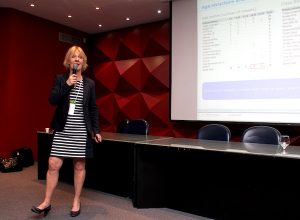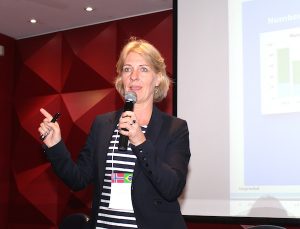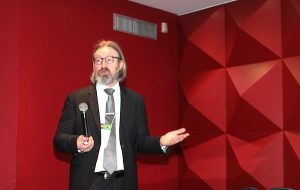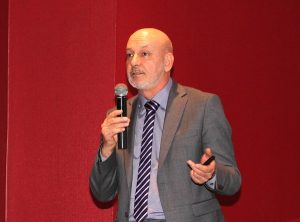
Catrine Vestereng, DNV GL.
The need for shuttle tankers is expected to increase in Brazilian waters, as pre-salt developments gain momentum.
Shuttle tankers are used to transport crude oil from offshore oil wells to terminals or refineries where subsea pipelines are not feasible, and major deployment areas include the North Sea and Brazilian offshore fields. A seminar on April 4, 2018, organized by NBCC, Innovation Norway and DNV GL, addressed how these tankers are considered «fit for purpose vessels» for Brazilian pre-salt. New offshore acreage without subsea pipelines, new regulations for emissions, requirements for safety and pressure over OPEX, combined with an aging fleet, are driving forces for a demand of new vessels with modern concepts, and Catrine Vestereng, Segment Director for Tankers at DNV GL, set the stage by presenting an overview of the global shuttle tanker market to the seminar.
«While the current fleet of shuttle tankers is 90 vessels, the fleet will reach 100 vessels by the end of 2020. Average age of scrapping is 24 years. Newbuilding contracting reached a peak in 2011, and most tankers were built in South Korea», Catrine Vestereng said.
There are two main owner companies of shuttle tankers – Teekay and Knutsen NYK, and the tankers are mainly deployed in the North Sea and offshore Brazil. DNV GL estimates that the replacement need will be of seven to nine vessels a year in the period of 2019-2022.
 «There are currently few orders for Brazilian waters, but this will come. Oil fields off the southeastern Brazilian coast will need shuttle tankers», the DNV GL executive states.
«There are currently few orders for Brazilian waters, but this will come. Oil fields off the southeastern Brazilian coast will need shuttle tankers», the DNV GL executive states.
Catrine Vestereng also presented an overview of the DNV GL operational experience with shuttle tankers – from a class perspective – where she focused on shuttle tanker performance.
«Shuttle tankers are performing in average better than tankers in general when it comes to safety and ISM. There is however an increasing number of findings with age, and hull related findings dominate», she said.
Mrs. Vestereng listed the typical mechanical findings, and identified anchor equipment as an operational challenge and valves and deck equipment as typical piping findings.
«What can we learn from this? Shuttle tankers are in general operated in a very good way, but we need to maintain focus on maintenance and training of the crew», she concluded.

Olav Tveit, DNV GL
Design developments
DNV GL Engineer and Ship Type Expert, Olav Tveit talked about regulatory framework and outlined the different rules and regulations in place both in the North Sea and in Brazil.
«In short, shuttle tankers are subject to the same statutory regulations as other crude tankers. In Brazil, the Normam regulations are in place and Petrobras also has guidelines. The same goes for other oil majors», Mr. Tveit said. He presented the main standards and guidelines that apply, and used the revised requirements of Exxon as one example. He also talked about how regulations are being enforced, about fuel types in the future and presented fuel demand projections.
«The energy efficiency drive is ongoing and affects ship design, also for tankers», Mr. Tveit said.
In a separate session, he talked about design developments for shuttle tankers in Brazil and globally. In general, Brazilian shuttle tankers have a higher cargo capacity. Terminal restrictions also play a role in design, and Mr. Tveit addressed different design issues like engine selection, propeller size, bow loading systems, cargo systems and valve requirements, machinery and thruster arrangements, power generation, fuel system arrangements and emissions standards for NOx (Nitrogen Oxides).
Mr. Tveit also talked about the new generation, LNG fueled, shuttle tankers, and innovative trends gaining ground.
Mr. Aleks Karlsen, also representing DNV GL, gave a presentation on Dynamic Positioning (DP). In areas with harsh environments, DNV GL expects a development towards higher technical requirements, more cost-efficient modes and lower environmental footprint. He talked about incidents involving DP and DP systems based on battery power.

Gilberto Beduhn, Petrobras.
Petrobras´point of view
Petrobras was also represented among the keynote speakers, and Mr. Gilberto Beduhn, DP, Power and Propulsion Consultant at Petrobras gave the closing presentation at the seminar. He shared Petrobras´ operational experience on shuttle tankers, and said that the first Petrobras shuttle tankers were conversions of conventional tankers, in 2002. Today the company has 38 units in operation and 11 more are contracted.
Petrobras uses FPSO in the offshore oil production and the oil is loaded on to shuttle tankers that take the oil to refineries onshore. Approximately 1100 off-loadings take place every year
«Today we have the 3rd generation of DP shuttle tankers operating in the Santos Basin. Our view is that the vessels need to evolve constantly, to cross new barriers. We need the shuttle tankers to be fit for purpose and reliability is fundamental. Petrobras has a trials perspective and believe in gaining operational experience through trials, also with our partners», he said.
By Runa Hestmann, NBCC journalist
(runa.tierno@nbcc.com.br)
Photo courtesy of RH and DNV GL
:

